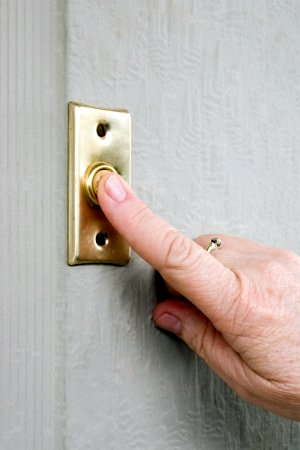

We may earn revenue from the products available on this page and participate in affiliate programs. Learn More ›
Ding, dong! Your guests have arrived for dinner and drinks. But if your doorbell stops working, you could leave your invitees out in the cold—extremely frustrating for both you and your guests. And if it’s not expected visitors, it’s a delivery service. A malfunctioning doorbell could make you miss FedEx or leave you with valuable packages just sitting there, outside your front door for anyone to grab.
Doorbells are often taken for granted, because these durable units can last 10 years, 15 years, or more without ever experiencing a glitch. But an outdoor location means that these electrical devices are exposed to all of the elements: broiling sunlight, rain, snow, sleet, and wind, to name a few. Any one or combination of these natural forces can cause a functional decline or outright failure. Before you call in a contractor and replace your entire doorbell system—a pricey proposition—take a few minutes to troubleshoot some of the most common problems.

Potential Problem #1: The Button
Sometimes, a physical blockage—like a clog from airborne dirt or spider nests—can prevent the doorbell button from operating. Press the button vigorously to see if it moves; if it’s stuck, clean well with a clean cloth soaked in rubbing alcohol or spray with some WD-40 to remove any debris. Should your button move freely, go a step further to try to confirm or rule out this potential source of the problem. Press the button again, this time listening for a low buzz. No buzz is no good; replace the button as soon as possible.
A helpful hint: Take the old button with you to the store, so that you can purchase a replacement that is the same size as the original—that way, you won’t have to replace the button panel.
Potential Problem #2: The Chime Box
If the pressing of the button isn’t the root of the problem, the malfunction might come from within the unit the unit that produces the sound or melody: the chime box inside the house. To determine if the box is damaged, first remove it from its mounting bracket on the wall. Take off the decorative cover, locate the two wires going to the unit, and attach the leads of a volt meter to each wire. Then have a handy assistant press the doorbell button: If the volt meter registers a signal, it means that the chime box is receiving electricity but is not working by sounding off. If no signal registers on the volt meter, it means there is a problem with the wiring to the box or the transformer (see below).
A chime box is filled with electronic circuitry, so repairing one typically requires a skilled technician. Often, the quicker, easier, and more cost-effective plan is to purchase a new chime box altogether. The options on the market today are seemingly endless, with sounds ranging from simple tones to recognizable tunes. Once you have found your replacement, simply hook up the two wires (which you have already disconnected from the original to test) and mount the new chime box on the wall—in some cases, you may need to replace the mounting brackets as well.
Potential Problem #3: The Transformer
For most of these cases, you can troubleshoot a doorbell without shutting off the main power, because doorbells operate on very low voltage. The one exception is when you need to test the transformer, which is generally located in or near the chime box. Cut the power before you begin, then conduct a visual inspection to look for any loose connections or wires that are completely disconnected. The wires may be marked “F” for front, “R” for rear, and “T” for transformer. If no wires are loose, you should check the transformer using a volt meter: Connect the leads of the volt meter to the two terminals on the transformer. A properly functioning transformer will show a meter reading that matches the secondary voltage as marked on it. If the meter reading is higher, it indicates that the transformer is faulty and needs replacement. A low reading, however, might just need a second test. Try changing the voltage range on the volt meter; if the readings still don’t match, replace the transformer. You might want to call in a pro for this type of repair.
Potential Problem #4: Faulty Wiring
Sometimes the wiring between the doorbell button and the chime box may be the problem. It may have been exposed to water; damaged by rodents; or simply become bent, twisted, or frayed. Start by checking the two wires connected to the button—if they are frayed or loose, splice in a new section of wire and reattach to the button. Do the same with the wires that are attached to the chime box. If the problem is damaged insulation on the wires, you can repair them with a little electrical tape.
To test the wiring between the chime box and the doorbell, disconnect the wires from the chime and hook them up to your volt meter. Have a friend or family member press the button while you check the meter for a signal. If nothing registers, you may need to run new wires—again, this might be a job for a professional.
Consider going wireless if you don’t feel comfortable replacing the wiring and would rather not call in a contractor. A number of wireless systems exist on the market today, growing in number and popularity since their advent in the ’90s. Utilizing radio waves rather than physical wiring to connect the button to the chime box, these battery-powered systems are extremely to install and replace.
